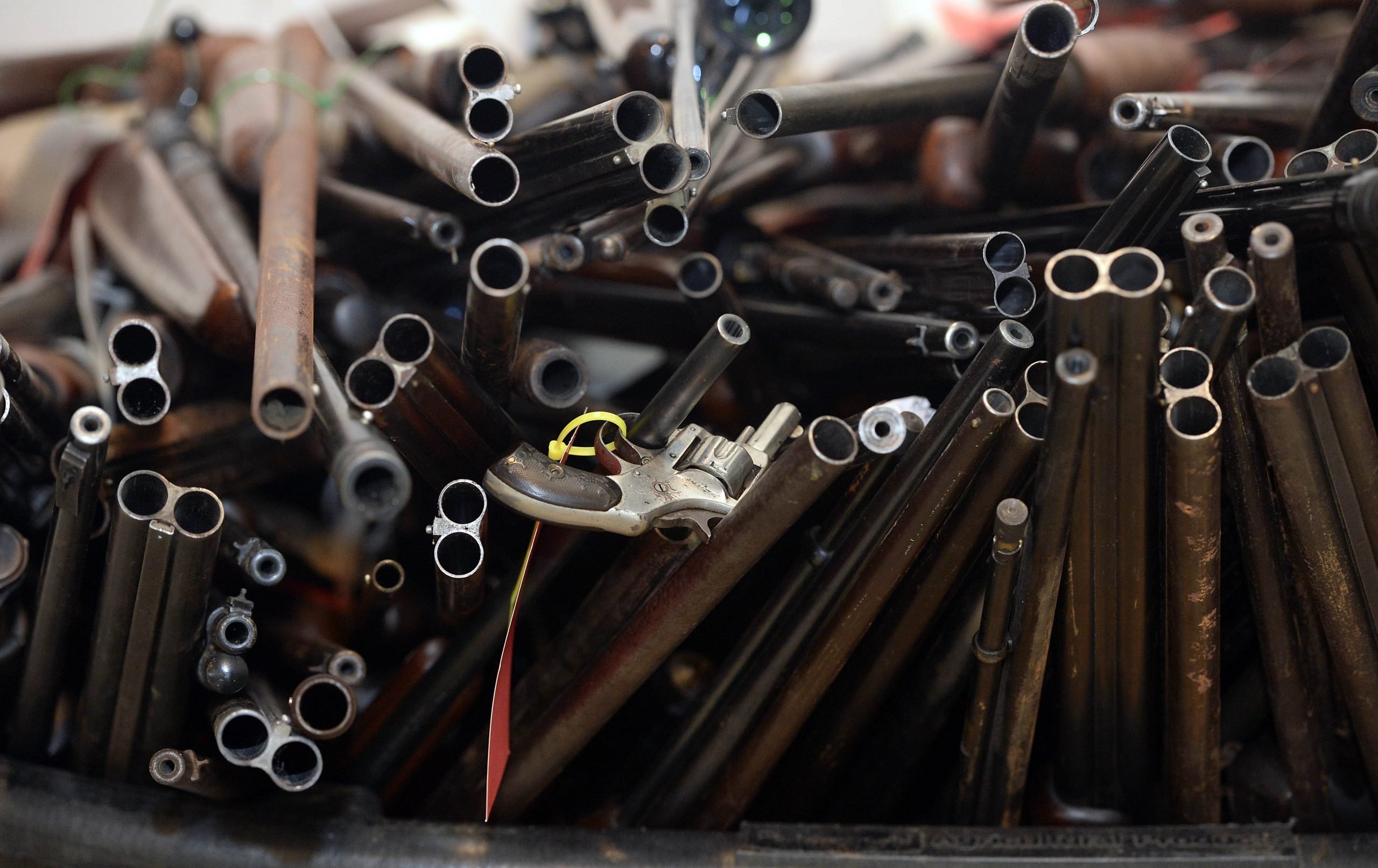What started as an effort to figure out the relationship between stolen guns and crime guns quickly grew to a scale that we never imagined. We began by sending public records requests — asking for the make, model, serial number, and other identifying information for stolen and recovered guns — to more than 100 of the biggest police departments in the country. As the data rolled in, we filed more requests with more police departments. And by the time we published our first story on Monday, we had amassed more than 800,000 records from 1,054 law enforcement agencies in 36 states.
We’ve spent the last few months cleaning and organizing the data, and reporting about stolen guns that became crime guns in Denver, St. Louis, and dozens of other cities. But we have only scratched the surface.
Shoddy recordkeeping by gun owners and law enforcement agencies, restrictive state public records laws, and federal limits on the public’s access to national data make reporting on the nexus between stolen guns and violent crimes enormously difficult. But there are several lessons we learned over the past year that may help journalists tell stories about how stolen guns are impacting their communities. Here’s a step-by-step guide for reporting on stolen guns.
Research and Plan
We began by filing public record requests for stolen and recovered guns with hundreds of law enforcement agencies. The good news: we may have already obtained the data you want. Find it here. (Did we obtain the records you are looking for? If so, feel free to skip ahead to the section about police records. Otherwise, keep on reading).
Familiarize yourself with your state’s public records laws, paying particularly close attention to what the laws say — or don’t say — about releasing information on stolen and recovered property. You’re going to run into more problems obtaining data on stolen and recovered guns from a state like Wisconsin — where the law exempts the release of data that “uniquely describe stolen, lost, confiscated, or recovered property” — than you are from, say, Colorado or Arizona.
Next, figure out which police departments and sheriff’s offices you want to target with your requests. We might have already obtained the data you want. If we did, it is available here.
If we didn’t, call several of the departments and try to speak to an analyst, property-and-evidence technician, or another employee knowledgeable about the department’s recordkeeping practices when it comes to stolen and recovered property. You might also be able to find some of this information in the department’s policy handbook. Some agencies post their policy handbooks on their websites.
Pay particularly close attention what an agency’s property-and-evidence management system is called and what records police officers or sheriff’s deputies are required to produce when they take a report on a stolen firearm or confiscate one that’s been used in a crime. If a records officer later denies your request on the grounds that the records don’t exist, having knowledge about the agency’s recordkeeping practices will help you argue otherwise.
Also, find out whether the department can produce data on stolen and recovered firearms in a spreadsheet-compatible format. Even though we specified we wanted the data in a spreadsheet, there were several instances in which the department provided poorly copied records on paper. Records officers often told us it was the department’s policy to only provide paper copies of public records. We were able to nevertheless convince them, in some cases, to provide it in a spreadsheet. Sometimes, this required sending a strongly worded, yet respectful, email pointing out that the state public records law requires agencies to release records in the format requested if the department has the records available in that format.
File Requests
Because we were filing records requests with so many different agencies in so many different states at once, we wrote a generic request broken into two parts. The first part requested the serial number, make, model, caliber and any other descriptive information for every gun reported stolen to the department from January 1, 2010, up to the date we filed the request. We also requested the case number for the theft, the date of the theft, the offense associated with the theft, and any other columns of data they were able to provide. The second part specified much of the same information, but for any gun that the department seized, confiscated, recovered, or otherwise took custody of and control over during the same time period.
Here is an example of a generic request that you can use for your reporting.

Be sure to specify in your request that you want the data in a .xls, .xlsx, .csv, or another spreadsheet-compatible file extension. Also, request any applicable data dictionaries to help you decipher column titles, acronyms, codes, etc. The NCIC codebook is also a good guide to figuring out what these values mean.
If your request is denied, fight it
If an agency rejects your request on the grounds that it is exempt from disclosure under public records law, do some more research and figure out the method for appeal.
The District of Columbia initially denied our request, citing laws that exempt from disclosure information that would “constitute an unwarranted invasion of personal privacy” or that would interfere with law enforcement proceedings. We appealed to the Executive Office of the Mayor, arguing that serial numbers were assigned to firearms, not individuals, and therefore could not interfere with a person’s privacy interests. We also highlighted how disclosure of the information was in the interest of public safety and pointed out that numerous other law enforcement agencies had complied with similar requests. The mayor’s office sided with us.
We filed a lawsuit to obtain records from the Chicago Police Department. In its denial of our request for serial numbers, Chicago cited a part of the Illinois public records law that exempts from disclosure “unique identifiers” and other private information, such as, the department wrote, “home address, serial numbers, and personal license plates…” But when we looked up the statute, we found that it made no mention of serial numbers at all. When we pointed this out, the department acknowledged inserting serial numbers for clarification purposes. The law firm Loevy & Loevy filed a lawsuit on The Trace’s behalf in July and the department released the information this month.
Clean and Compile the Data
The data you receive will be dirty. Police officers by and large are not weapons experts, and it can be remarkably difficult to decipher which grouping of letters or numbers means what on a firearm. We spent much of the past year scrubbing makes and patent numbers that were mistakenly entered as serial numbers, standardizing the rows of data, and cleaning any other errors we stumbled across.
Once you have your data, compile it all into one sheet so you can do all this at once. OpenRefine is a great tool for cleaning data quickly, though it will take some time to learn if you’re not familiar with it.
When you get your data, pay attention to whether the department codes its records in a way that indicates the gun was previously stolen. Often times, if you see “Recovered” in the record, that means the gun was previously reported lost or stolen. But you should confirm this with the department.
Once your data is cleaned and in one place, you can connect the serial numbers, makes, and other identifying information from guns reported stolen to those that were seized, confiscated, recovered, etc., and identify crimes in which police recovered a stolen weapon.
Caution: You cannot rely on serial numbers alone when connecting stolen and recovered guns. Different firearms manufacturers are legally allowed to use the same serial numbers. For example, there could be a Smith & Wesson pistol with serial number 12345 and a Glock with serial number 12345 and that would be allowed under the law. That’s why the other identifying information — particularly the make — is important. If you identify two guns of the same brand with the same serial number, you can be sure it’s the same weapon.
Now, it’s time to get police reports
Once you have identified cases in which stolen guns were involved in crimes, take note of the case numbers. Next, file a request with the agency for the police reports. Police departments often call them incident reports, offense reports, or arrest reports. We sometimes lumped these terms together into one sentence to ensure we didn’t miss out on any important documents:
Dear Records Officer,
Pursuant to the (insert open records law), I hereby requests the police reports, incident reports, offense reports, arrest reports, and/or any and all other material available under the following case numbers:
The last clause — any and all other material — proved important because agencies sent us photos and audio recordings of witness statements that we didn’t specifically request but were useful. However, it’s generally best to request precisely what you want. This helps speed up the processing of your request.
If you have time, try contacting the police department to find out whether the case is open or closed. In states like Kansas and Missouri, you’re likely to not receive much information if the investigation hasn’t been completed.
The police reports will yield important information about the theft and the recovery, as well as about gun owners and victims of crime whom you may be able to interview. If you find them lacking in detail, try going to the courthouse and obtaining records on the defendants. In Georgia, for example, you’re liable to find stacks of documents in the discovery material that the police department may not provide.
Put the thefts in context
Here are some reporting questions you might ask, about what might be contributing to gun theft in your community:
- Does my state or city have a law requiring gun owners to report lost or stolen firearms?
- Does my state or city have a law mandating how guns are stored in the home? What does the law say about transporting or storing guns in vehicles?
- Is my city in a “preemption state,” which forbids municipalities from creating their own gun restrictions?
- Have my state’s laws changed recently, particularly regarding the ability to carry guns in public?
- Is there any available research about gun-ownership rates or behaviors in my state?
- Has my police department launched initiatives to prevent gun thefts?
If you have any questions about reporting on stolen guns or would like to learn more about Missing Pieces, shoot me an email at [email protected].


